Barry Levinson’s 1997 film starring Robert De Niro and Dustin Hoffman “Wag the Dog” is one of my favortie movies. I confess to having seen it more than 12 times. While widely recognized as a biting commentary on political spin and media collusion, it also offers invaluable insights for the business world. It is not just a political satire but also a playbook for managing perception in the age of instant media.
Here are some key lessons I believe businesses can derive from the film:
Brand Perception is Key
Much like in politics, in business, perception often becomes more significant than the actual product or service. It’s not always about what you’re selling but how consumers perceive its value. In an age of digital influence, managing this perception is more vital than ever.
Distraction as a Strategy
When facing negative PR or a crisis, introducing a new narrative, product, or campaign can redirect public attention. However, this tactic should be used judiciously, as overuse can erode trust.
Collaboration between Marketing and PR
The film showcases a seamless partnership between a Hollywood producer (symbolizing marketing) and a spin doctor (PR). Businesses should ensure close alignment between marketing and PR to convey a consistent brand message.
Critical Analysis of Information
As the film teaches viewers to question media narratives, businesses should critically analyze market data, customer feedback, and trends before making strategic decisions.
The Role of Technology in Crafting Narratives
The ease with which narratives were digitally fabricated in the movie is a testament to the power of technology in shaping brand stories. Businesses must leverage technology responsibly to enhance authenticity, not deceive.
Emotional Connect Over Cold Facts
People relate to stories and emotions more than plain data. Brands that evoke emotion, like the film’s war anthem, “Good Old Shoe”, are likelier to foster loyalty and engagement.
The Perils of Over-manipulation
While managing perception is crucial, being overly manipulative can backfire. Authenticity and ethical practices are vital for long-term brand credibility.
Ethical Responsibility
Businesses, like the movie’s media professionals, have a moral obligation. They must ensure that while crafting narratives, they do so with integrity, transparency, and authenticity.
So for me, “Wag the Dog” isn’t just a reflection on media and politics; it offers a deep dive into the world of perception management, vital for modern businesses. I believe that for leaders and marketers, understanding the film’s nuances can provide a roadmap for ethical and effective brand management in an increasingly sceptical world.

Leave a Reply